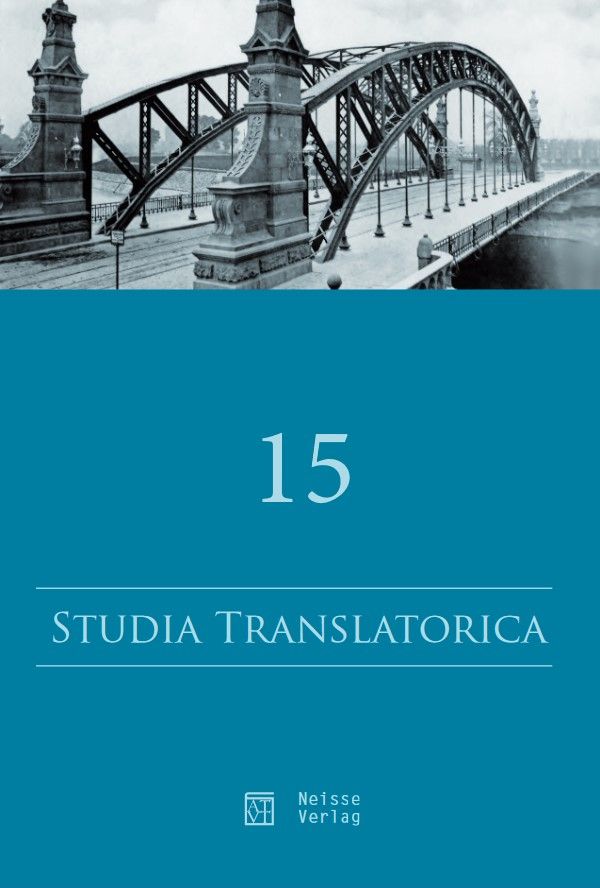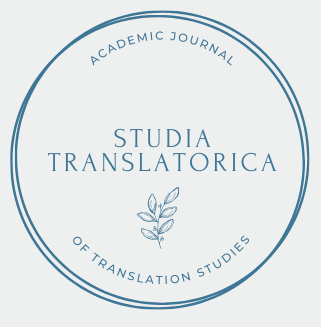
Studia Translatorica
Issue 15 (2024): Song Translation Studies. Studien zum Übersetzen von Liedern
Edited by: Johan Franzon, Anna Rędzioch-Korkuz, Michał Gąska
Introduction to volume 15 of the journal “Studia Translatorica” on song translation studies
DOI: 10.23817/strans.15-1 (published online: 2024-10-06)
Keywords:
Einführung in den 15. Band der Zeitschrift „Studia Translatorica“ zu Studien zum Übersetzen von Liedern
DOI: 10.23817/strans.15-2 (published online: 2024-10-06)
Keywords:
Song and translation – song translation studies / Song and translation – song translation studies
DOI: 10.23817/strans.15-3 (published online: 2024-10-06)
Received: 2023-11-20
Accepted: 2024-01-13
Keywords: song, song translation, multimodality, tradaptation, transcreation
The article overviews recent research in song translation studies. A growing interest and the not-too-coherent wealth of case studies need to be made relatable to one another. The article asks what makes song a special object for translation studies and what a map of song translation studies should encompass. The answer suggests three cornerstones: source-oriented, transfer-oriented and target-oriented studies. The first would need some acquaintance with musical verse and a fluid definition of song; the second some kind of multimodal conceptualization – one that allows both plain prose translation of song lyrics, such as in for example subtitling, and much variable audiovisual adaptations, such as, for example, the many YouTube videos of Shervin Hajipour’s “Baraye”; and the third would need to chart the long-term afterlives of songs, conceptualizing their post-translation use in manifold ways. The discussion is exemplified by translations of Bertolt Brecht and Pete Seeger’s “My rainbowrace”.
Rhythm and blues song translation during the yé-yé period in France and Spain
DOI: 10.23817/strans.15-4 (published online: 2024-10-06)
Received: 2023-09-29
Accepted: 2024-01-15
Keywords: R&B, marketing, minority, yé-yé, censorship, translation
Music is said to be a powerful, universal tool capable of taming savage beasts when skillfully wielded. During the years 1958 through 1968, known as the yé-yé period, anglophone forms of popular music made a significant impact on the southwestern corridor of Europe, inspiring a cultural revolution among teenagers. The increased demand for anglophone art and cultural productions led to a surge in the release of singable pop song translations, including a considerable amount of rhythm and blues (R&B) music. This article, which is an exploratory study, seeks to discover the discursive and sociopolitical implications of singable American R&B song translations commercially released in France and Spain during this period. The song translators’ strategies, the semantic and semiotic retentions in the cover recordings, as well as the sociocultural context are discussed in four song examples that seem most representative of the manifestation of R&B in France and Spain.
From Waterloo Road to the Champs-Elysées. A study of French translations of British and American pop songs
DOI: 10.23817/strans.15-5 (published online: 2024-10-06)
Received: 2023-09-28
Accepted: 2024-01-13
Keywords: song translation, British and American pop music, post-war period, lyrics, French singers
This paper investigates French versions of British and American pop songs from the post-war period until the early twenty-first century. The aim is to establish which translation methods were used when the songs were transferred into the target language and covered by French artists. Fifty target texts were analyzed by means of Franzon’s typology of popular songs in translation. The corpus material was analyzed with regard to such factors as distribution among categories in the typology, the lyrical themes of the texts, the choices of individual translators, and the way these translators transferred the works of different composers. The results show that, even though no significant development over time could be detected, translation methods were rather evenly distributed on the spectrum between the fairly faithful variants and target texts bearing no resemblance in content to the source texts. The results also indicate that protest/anti-war lyrics were more faithfully transferred into the target language than texts exploring other lyrical themes. The domination in the corpus of covers made in the 1960s seems to reveal that decade as a golden age of pop song translation from English into French.
Singing within constraints: Strategies of translating songs on early Polish National Television
DOI: 10.23817/strans.15-6 (published online: 2024-10-06)
Received: 2023-09-24
Accepted: 2024-01-13
Keywords: translation and music, singability, song text, translation strategy, multimodality, constraints
The relationship between the word and sound seems best exemplified in song. The indefinite and semantically broad meaning of music becomes more specific and precise thanks to words, which are believed to belong to amore conventionalised semiotic system. However, in the process of singable translation this intrinsic connection between the word and sound may become distorted because of various reasons, including the question of the target context or the profile of target audiences and their expectations. This paper presents a descriptive analysis of strategies used in translating foreign songs presented in four early episodes of the entertainment show „Muzyka lekka, łatwa i przyjemna”, aired on Polish National Television since the 1960s. Apart from global observations drawn from the overview of translation strategies across the analysed episodes, the paper presents also amore explanatory and multimodal analysis of singable translations of English-language songs and highlights the problem of context-driven constraints.
I am not throwing away my shot! (at discussing multimodality): How a multimodal analysis can support song translation– the case of “Hamilton”
DOI: 10.23817/strans.15-7 (published online: 2024-10-06)
Received: 2023-09-29
Accepted: 2024-01-13
Keywords: translation, multimodality, stage musicals, song translation, themes
Stage musicals stand out for their multimodal nature, and thus convey meaning through verbal, audio and visual semiotic resources. So far, studies on the translation of musicals have focused mainly on lyrics, without taking into consideration their multimodal nature; when the topic of the multimodality of songs has been researched, it was mostly in popular music and opera. When it comes to stage musicals and their translation, it is evident that there is a lack of substantial research on how meaning is expressed through interaction between modes. However, due to their nature, stage musicals require a multimodal translation approach. To tackle this, the paper presents a model of analysis that considers the semiotic complexity of these songs and demonstrates how they use verbal, audio and visual resources to further the plot. This model was applied to the musical “Hamilton” (2015) to understand the role of multimodality in a modern stage musical and to address the question on how to tackle its translation.
How music and lyrics interact: A translation-oriented analysis of musical narrative in Disney’s “Let it go”
DOI: 10.23817/strans.15-8 (published online: 2024-10-06)
Received: 2023-05-29
Accepted: 2024-01-13
Keywords: audiovisual translation, Disney, musical narrative, music semantics, song translation
Much research on song translation focuses on formal constraints, such as rhyme and rhythm, but few studies seem to investigate the relationship between lyrics and music itself. This study examines how meaning is constructed in music, and how the meaning of music interacts with the meaning of lyrics in a song translation context. The analysis follows three paradigms of meaning in music: musical narrative, music rhetoric, and music semantics. These paradigms are used to describe the meaning of the music of the Disney song “Let it go”, from the 2013 musical film “Frozen”. Disney songs are some of the most commonly translated songs, and as such, they have an important effect on child development. It is found that on a general level, the music of “Let it go” expresses a victory of a rebellious force over an established order, which is expressed by means of a growth of energy and intensity. This growth closely follows the four rhetorical phases of the narratio, probatio, dubitatio, and peroratio, which allows for a structural analysis of musical meaning and narrative. The findings suggest that treating the music of a song as a central element can guide the translation process and scholarly analysis of songs and their translations. This study stresses the importance of the role of music in the multimodal product that is a song.
The marriage of modes: Singable opera translation
DOI: 10.23817/strans.15-9 (published online: 2024-10-06)
Received: 2023-09-29
Accepted: 2024-01-13
Keywords: multimodality, intersemiosis, Mozart, Jeremy Sams, opera
Despite the increase in scholarly articles and publications that focus on singable translations of vocal music texts, few tackle the relationships and interplay between the two main semiotic systems of words and music, nor how they may or may not be preserved in translation. The translator’s understanding of how meaning arises across semiotic resources, especially between music and words, is equally as important a criterion for decision making when translating a vocal music text as sense, naturalness, singability, rhythm and rhyme and deserves as much attention as any staging demands or the diverse requirements of cultural transfer. By means of demonstration, using examples from a translation of Mozart’s “Le nozze di Figaro” by Jeremy Sams, this study explores an approach to singable opera translation that focuses on the stylistic decisions of the composer when marrying verbal and non-verbal semiotic modes and how the translator preserves or alters their relationship, which in turn may affect their interpretation, especially by singers.
Translating songs between endangered and modernized languages: The case of Ryukyuan in Okinawa, Japan
DOI: 10.23817/strans.15-10 (published online: 2024-10-06)
Received: 2023-09-28
Accepted: 2024-03-11
Keywords: indigenous song translation, language documentation, ethnolinguistics, language shift, translation studies
Examining the severely endangered languages of the Ryukyuan Archipelago from a translation studies perspective reveals that song is the only domain where translation is occurring, and that this translation has hardly been researched. This leads to more serious questions that remain understudied, such as how to translate indigenous languages and indigenous nonconformist concepts into the world’s modern dominant languages or how to address all the sociolinguistic issues that accompany those decisions. A song translation studies perspective provides an insightful metric for exploring how translation is taking place in Okinawan music. This study investigates three translation projects, including an archival documentation of song translations from Ryukyuan into Japanese, English subtitles for videos, and singable cover versions of songs translated from Japanese into Ryukyuan. The problems and decisions made in these contexts are documented to foster discussion and to encourage further translation research into indigenous languages.
Translation und Zyklizität: Zur Übersetzung der „Winterreise“ von Wilhelm Müller und Franz Schubert durch Bélanger / Translation and cyclicality: On the translation of the “Winterreise” by Wilhelm Müller and Franz Schubert by Bélanger
DOI: 10.23817/strans.15-11 (published online: 2024-10-06)
Received: 2023-11-06
Accepted: 2024-01-26
Keywords: song cycle, translation, Wilhelm Müller, Franz Schubert, Bélanger
The purpose of this article is to elaborate, in a descriptive manner, on selected aspects of the cyclical structure of Wilhelm Müller’s and Franz Schubert’s “Winterreise” (1827, D911) and the effects that intercultural transfer and language change can have on it. For this purpose, first some theoretical considerations on the cyclicality of the song collection in general and the “Winterreise” in particular are collected in order to then exemplarily deal with the concrete references of a selected song to the other songs of the cycle both in original and translation. An early French translation of the song cycle by the French translator Bélanger is consulted here. The analysis shows how the translational (especially the lexical) choices of the translator in the individual songs can lead to a changed understanding of the whole song cycle.
Translating the songs of the “Sirens” in James Joyce’s Ulysses
DOI: 10.23817/strans.15-12 (published online: 2024-10-06)
Received: 2023-09-26
Accepted: 2024-01-13
Keywords: musicalized fiction, allusion, quotation, intermediality, intradiegetic, extradiegetic
Song lyrics function in James Joyce’s “Ulysses” like any other literary and cultural allusion. However, in the musical episode of “Ulysses”, “Sirens”, lyrics may function as music as well. In the episode, where songs are performed by characters and, de facto, by the narrative itself, musical allusions are evoked in the readers’ mind, enriching their experience of the episode. The following question may arise then: how can the Sirens’ songs be translated for a target reader who is not familiar with the music or words of the songs mentioned? Addressing foundational word and music studies research and recent research on the translation of musical texts, this article investigates how lyrics alluded to in “Sirens” perform a musical role in the episode. Through the study of the Italian and Finnish (re)translations of the episode, it examines the creative options for translators of song lyrics in musico-literary texts.
The ensemble of death and dance: Songs of The Tiger Lillies in Polish translation by Szymon Jachimek
DOI: 10.23817/strans.15-13 (published online: 2024-10-06)
Received: 2023-09-27
Accepted: 2024-01-13
Keywords: song translation, appropriation, punk cabaret, Tiger Lillies, Szymon Jachimek
This paper analyses the modifications introduced by Szymon Jachimek in his translation of The Tiger Lillies’ songs, used in a Polish theatrical production in 2016. The Tiger Lillies, A British band, represent an alternative genre of punk cabaret, characterised by dark, transgressive humour, inspirations drawn from Weimar-era cabaret, and neo-Victorian aesthetics. Based on selected examples and taking into consideration the intersemiotic elements of music and performance, I discuss the deviations from the source text introduced by the translator: from (self)censorship of religious irreverence to far-reaching domestication shifting the material towards topical political satire. Rather than considering such deviations as precluding the text from being a translation per se and branding it adaptation, I instead perceive them as expressions of creativity and appropriation, reconstructing the means and aims of making the material “one’s own”. The paper, it is to be hoped, will form an invitation to further study of the creative capacities and the authorial competence of song translators.
Activating creativity in translation training courses through song translation
DOI: 10.23817/strans.15-14 (published online: 2024-10-06)
Received: 2023-09-06
Accepted: 2024-02-06
Keywords: song translation, creativity, creative shifts, translation training, artificial intelligence
The aim of this paper is to present possible applications of song translation in translation training courses as away to encourage a creative mindset among translation students. The songs selected for the activities under discussion came from “Six: The musical”. The genre of a musical was chosen because of the multimodal nature of musical theatre. In a musical, consideration must be given to the limitations imposed by music as well as the plot, stage movements, or the need to differentiate between registers used by characters. Students undertook translational actions using the five choices described by Franzon; however, they started with the additional step of machine translation. The translations prepared by students were compared and discussed in class, as well as contrasted with the machine-generated text. The translated versions were analyzed following the creativity markers proposed by Bayer-Hohenwarter.
Beat music, sláger, and different song translations in Socialist Hungary [Ignász, Ádám (ed.) (2023). Translation, adaptation, and intertextuality in Hungarian popular music. (Jazz under State Socialism. Volume 8). Lausanne et al: Peter Lang. Pp. 282]
DOI: 10.23817/strans.15-15 (published online: 2024-10-06)
Received: 2024-06-27
Accepted: 2024-07-02
Keywords:
Between translation and semiotics and into artistic transduction [Gorlée, Dinda L. (2023). From mimetic translation to artistic transduction: A semiotic perspective on Virginia Woolf, Hector Berlioz, and Bertolt Brecht. London/ New York: Anthem Press. Pp. 202]
DOI: 10.23817/strans.15-16 (published online: 2024-10-06)
Received: 2024-02-14
Accepted: 2024-06-06
Keywords:
Das Übersetzen von Kunstliedern vor dem Hintergrund der funktionalen Translationswissenschaft [Kvam, Sigmund (2024). Poesie– Musik– Übersetzung. Varietäten in der Translation von Liedtexten. (TransÜD– Arbeiten zur Theorie und Praxis des Übersetzens und Dolmetschens, Bd. 142). Berlin: Frank&Timme. 197 S.]
DOI: 10.23817/strans.15-17 (published online: 2024-10-06)
Received: 2024-03-20
Accepted: 2024-06-06
Keywords:


